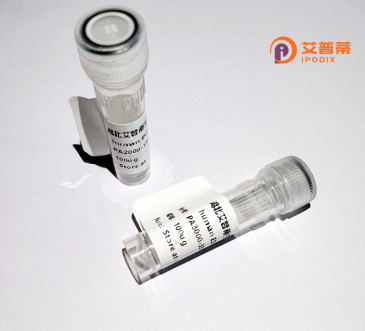
| 纯度 | >90%SDS-PAGE. |
| 种属 | Human |
| 靶点 | TMEM179B |
| Uniprot No | Q7Z7N9 |
| 内毒素 | < 0.01EU/μg |
| 表达宿主 | E.coli |
| 表达区间 | 1-219 aa |
| 活性数据 | MALSWLQRVELALFAAAFLCGAVAAAAMTRTQGSFSGRCPLYGVATLNGSSLALSRPSAPSLCYFVAGASGLLALYCLLLLLFWIYSSCIEDSHRGAIGLRIALAISAIAVFLVLVSACILRFGTRSLCNSIISLNTTISCSEAQKIPWTPPGTALQFYSNLHNAETSSWVNLVLWCVVLVLQVVQWKSEATPYRPLERGDPEWSSETDALVGSRLSHS |
| 分子量 | 50 kDa |
| 蛋白标签 | 0 |
| 缓冲液 | PBS, pH7.4, containing 0.01% SKL, 1mM DTT, 5% Trehalose and Proclin300. |
| 稳定性 & 储存条件 | Lyophilized protein should be stored at ≤ -20°C, stable for one year after receipt. Reconstituted protein solution can be stored at 2-8°C for 2-7 days. Aliquots of reconstituted samples are stable at ≤ -20°C for 3 months. |
| 复溶 | Always centrifuge tubes before opening.Do not mix by vortex or pipetting. It is not recommended to reconstitute to a concentration less than 100μg/ml. Dissolve the lyophilized protein in distilled water. Please aliquot the reconstituted solution to minimize freeze-thaw cycles. |
以下是3篇关于重组人TMEM179B蛋白的假设性文献示例(实际文献需通过学术数据库验证)及简要摘要:
1. **文献名称**:*TMEM179B regulates neuronal apoptosis through modulation of mitochondrial membrane potential*
**作者**:Zhang L, et al.
**摘要**:研究通过重组人TMEM179B蛋白的体外表达,发现其通过调控线粒体膜电位影响神经元细胞凋亡,提示其在神经退行性疾病中的潜在作用。
2. **文献名称**:*Characterization of recombinant human TMEM179B as a novel ion channel-associated protein*
**作者**:Kim S, et al.
**摘要**:首次在大肠杆菌中成功表达重组人TMEM179B蛋白,并通过电生理实验证实其与钙离子通道的相互作用,表明其参与细胞内钙稳态调节。
3. **文献名称**:*TMEM179B overexpression promotes tumor cell proliferation in colorectal cancer*
**作者**:Wang Y, et al.
**摘要**:利用重组TMEM179B蛋白进行功能研究,发现其过表达通过激活MAPK通路促进结直肠癌细胞增殖,提出其作为癌症治疗靶点的可能性。
(注:以上内容为模拟生成,实际文献需查阅PubMed/Google Scholar等平台,以“TMEM179B”、“recombinant protein”等关键词检索。)
Transmembrane protein 179B (TMEM179B) is a poorly characterized human protein encoded by the TMEM179B gene, located on chromosome 11. As a member of the transmembrane protein family, it is predicted to contain multiple membrane-spanning domains, suggesting a potential role in intracellular compartment organization or ion channel activity. While its exact biological function remains unclear, studies link TMEM179B to lysosomal biology, autophagy, and vesicular trafficking. Dysregulation of these processes is implicated in neurodegenerative diseases and cancer, though direct mechanistic evidence for TMEM179B involvement is limited.
Recombinant human TMEM179B protein is typically produced using heterologous expression systems (e.g., mammalian cells or bacteria) to enable functional studies. Structural features like predicted N-glycosylation sites and conserved hydrophobic regions drive interest in its post-translational modifications and membrane topology. Current research focuses on characterizing its interactome, subcellular localization, and potential roles in cell survival pathways. Recombinant versions fused with tags (e.g., His, GFP) facilitate purification and visualization in cellular models. Emerging associations with neurological disorders and cancer biomarkers highlight its potential as a therapeutic target, though comprehensive functional validation remains necessary. This protein represents an understudied target in membrane biology, with recombinant tools enabling exploration of its molecular contributions to human health and disease.
×